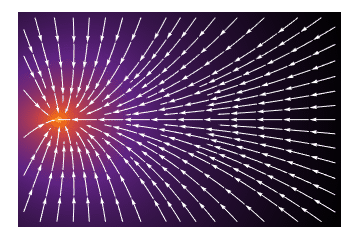Observing neutrinos requires getting rid of light from neutral bremsstrahlung
Radioactive isotope 136Xe can undergo a special kind of decay known as double beta decay. In that event, two electrons and two neutrinos are emitted from the xenon atom. If the neutrino is its own antiparticle, a so-called Majorana particle, two neutrinos in the same region of space have a chance of annihilate themselves, and only electrons could be observed. The actual mechanism is rather complex, but at the end of the day, if the neutrino is a Majorana particle, a double beta decay could only emit two electrons and not the whole pack of electrons and neutrinos. The NEXT experiment, an underground particle detector in Spain, aims to detect precisely that: a neutrinoless double beta decay. The point for us now being that the experiment uses a detector full of pure 136Xe.
It happens that, when ionizing radiation interacts with xenon, copious amounts of ultraviolet light are emitted at particular wavelengths—an “electroluminescence” that is leveraged in dark matter searches or neutrino detectors. But researchers were not aware of the presence of another, fainter, light emission over a broader wavelength range, from the ultraviolet to the near infrared. Therefore, scientists explained the corresponding light pulses as being due to impurities in the gas. Now, a team of researchers shows 1 that these pulses are instead signals of a new kind of light emitted in xenon, caused by the scattering of electrons onto neutral atoms.

When a metal target is bombarded by fast electrons a X-rays are produced. The X-rays are the result of a charged particle, in this case a fast charged electron, is rapidely slowed down, as when it passes through the electric field around an atomic nucleus. Consequently, this radiation is known as ‘braking radiation’, only that in German, Bremsstrahlung. Using studies in a small laboratory system expressly conceived for this purpose, the researchers identify this new light—dubbed neutral bremsstrahlung—in the large detector of the NEXT experiment.

Given the limited size of the detector, its xenon purity is very well controlled. In addition, the scintillation emission from a specific region of the detector can be precisely isolated and studied under very well controlled conditions, both when electroluminescence can and cannot occur. These features allow the observation and study of scintillation emissions other than electroluminescence.
The researchers also develop a robust theoretical model for the neutral bremsstrahlung, which describes the experimental data very well and allows to unambiguously assign the observed scintillation mechanism to neutral bremsstrahlung.
Now, scientists know that discovering dark matter and observing neutrinos requires more than just making the xenon pure inside of large detector systems. Researchers should also separate the light due to neutral bremsstrahlung to optimize the design of the detectors and to improve their sensitivity.
Author: César Tomé López is a science writer and the editor of Mapping Ignorance
Disclaimer: Parts of this article may have been copied verbatim or almost verbatim from the referenced research paper/s.
References
- C.A.O. Henriques et al – The NEXT Collaboration (2022) Neutral Bremsstrahlung Emission in Xenon Unveiled, (NEXT Collaboration). Phys. Rev. X doi: 10.1103/PhysRevX.12.021005 ↩